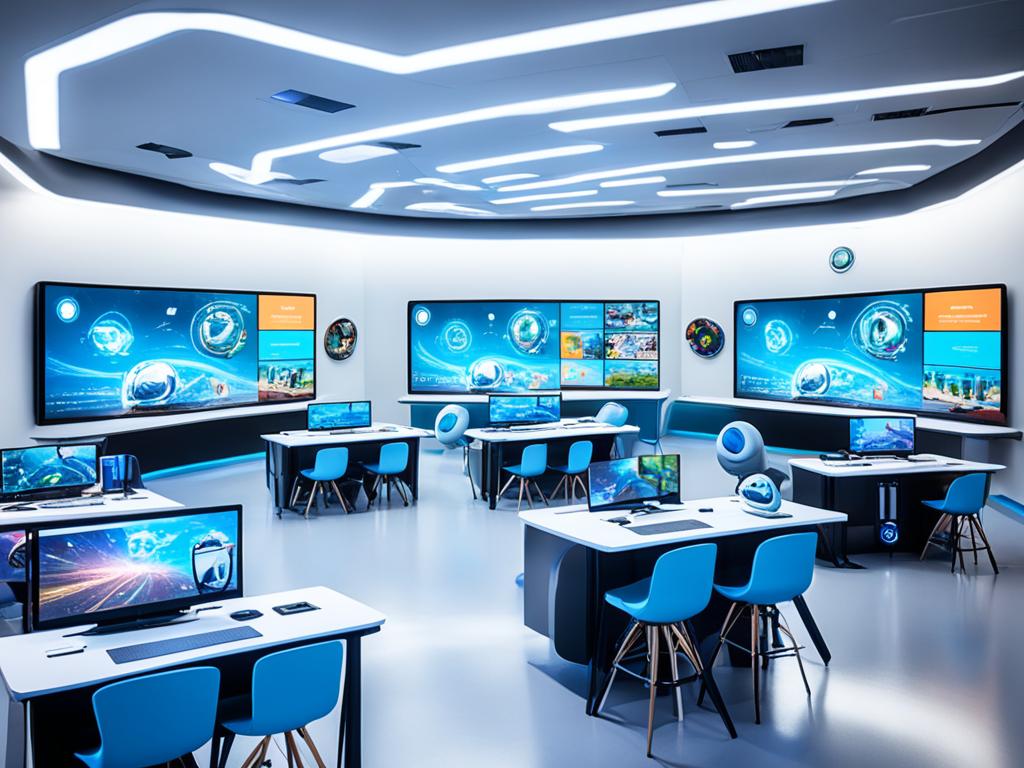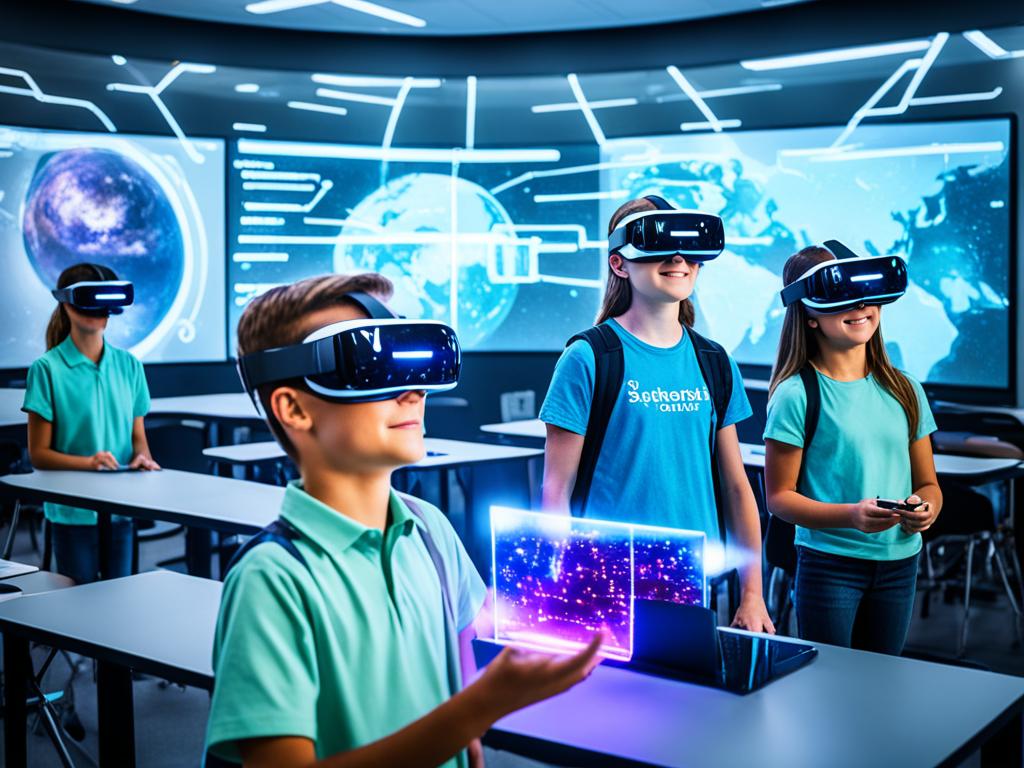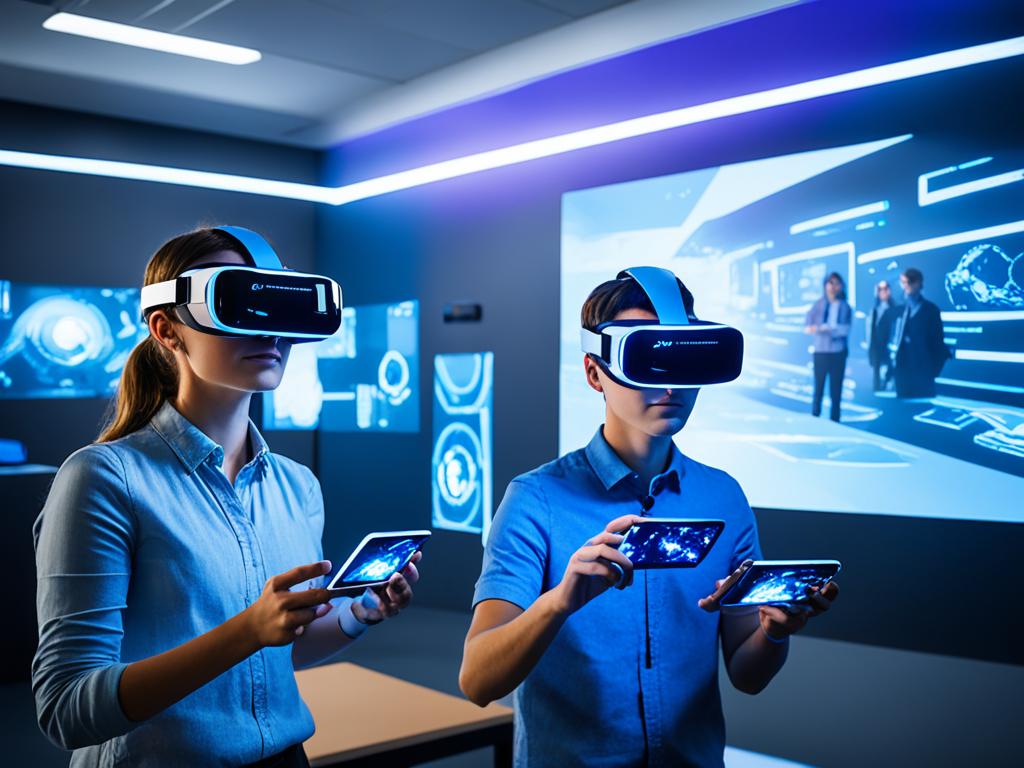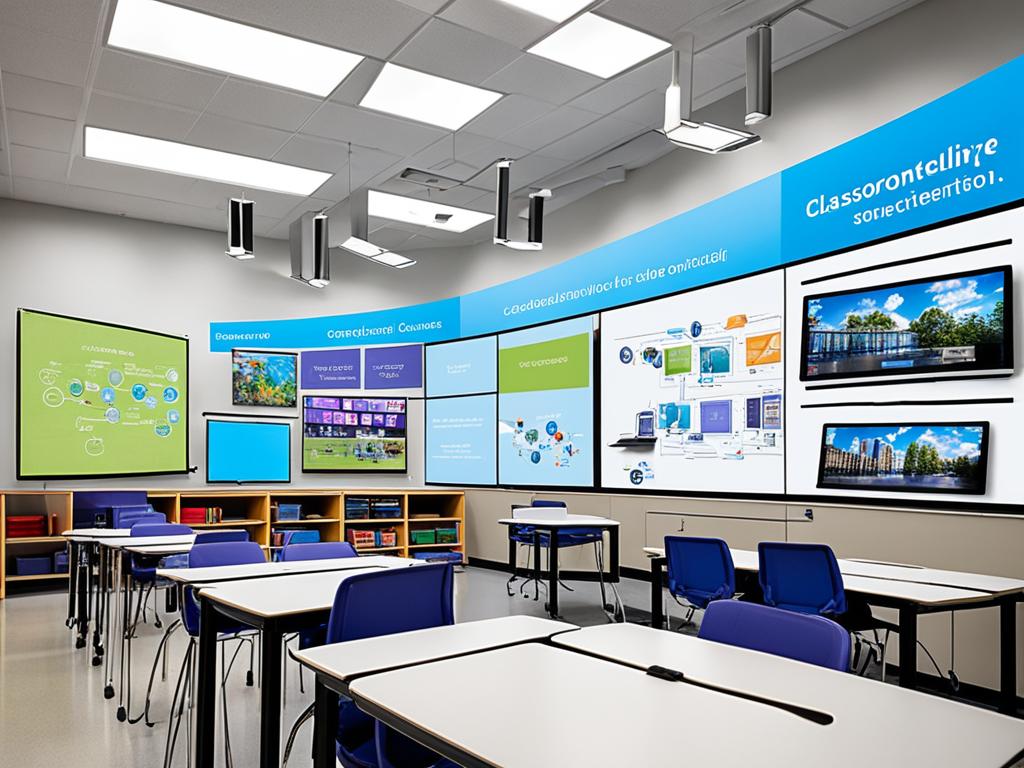
Educational Technology in Modern Learning
Education is changing fast, thanks to technology. It’s making learning better and opening new ways to teach. This article will look at how educational technology is changing learning. We’ll see the main trends and benefits of using technology in schools.

Technology has brought a new way of learning. It’s making classrooms more lively and sometimes even replacing them. New tools like learning systems, online platforms, and adaptive learning are changing how students learn, work together, and get help.
Teachers use technology to make learning fun and fit different learning styles. With things like interactive media and smart learning tools, tech can make learning better. It can also help students do better in school and understand their subjects better.
The Rise of Educational Technology
In recent years, education has changed a lot thanks to new tech. This change has made learning better for students and helped teachers do their jobs better.
Transforming the Classroom Experience
Technology has changed how we teach and learn in the classroom. Now, instead of just listening to a teacher, students use tablets and laptops to learn. They can interact with each other and access lots of digital resources.
Benefits of Integrating Technology in Education
Adding tech to education has many benefits, including:
- Improved learning outcomes as students learn better through interactive lessons.
- Enhanced student engagement as tech makes lessons more interesting for today’s students.
- Personalized instruction through learning platforms that adjust to each student’s needs.
Thanks to these tech changes, learning is now more exciting and focused on what students need. This has opened up new ways to learn and use technology in the classroom.

Learning Management Systems: The Digital Classroom
In today’s world, learning management systems (LMS) are key to modern education. They change how we learn online, turning old classrooms into lively digital ones. With LMS, teachers can give full online courses, talk with students online, and keep track of student progress easily.
Big names like Blackboard, Canvas, and Moodle have lots of features for digital learners. They make it easy for teachers to manage courses, share materials, and check on students. They also have tools for students to talk, study together, and work on projects online.
Using LMS has changed online learning a lot. Schools can now give students a full digital learning experience. Students can get to course materials, join live sessions, and get feedback from anywhere.

The role of LMS in education is huge as it keeps changing. These tools make learning better and give teachers the tools to create engaging, personalized, and team-based digital classrooms.
Educational Technology
Modern learning has seen a big change thanks to educational technology. It’s changed how students interact with their lessons and teachers. At the center, e-learning platforms and online courses have made learning flexible and easy to get into.
Educational Technology: E-Learning Platforms and Online Courses
E-learning platforms and online courses are getting more popular. They meet the different needs of learners. They offer the chance to learn at your own speed and access resources from anywhere with internet.
Using educational software, these platforms make learning smooth and fun. Students can learn at their own pace and get the knowledge and skills they need.
Adaptive Learning and Personalized Instruction
With e-learning, adaptive learning and personalized instruction have become big things. These methods use data to make learning fit each student’s needs. Educational software helps these systems change the content and difficulty level for each student.
This new technology has changed education a lot. It helps both learners and teachers. As we keep exploring e-learning, online courses, adaptive learning, and personalized instruction, the future of educational technology looks bright and very focused on each student.

Instructional Design: Enhancing Learning Experiences
In the world of educational technology, instructional design is key. It makes learning fun and effective. Designers use their skills to make materials that meet students’ needs.
Educational Technology: Multimedia and Interactive Learning Materials
Using multimedia learning techniques, designers grab learners’ attention. They make learning more engaging with interactive content and educational technology. This mix creates a deeper learning experience.
- Using multimedia like videos, animations, and simulations to help learners remember important ideas
- Creating interactive tasks that get learners involved and active
- Adding adaptive and personalized learning to fit each learner’s way of learning
- Designing easy-to-use instructional design interfaces for smooth learning
By applying these instructional design methods and educational technology, learning becomes better. Students keep more of what they learn and can apply it in real life.

Educational Technology: Virtual Classrooms and Remote Collaboration
The COVID-19 pandemic made educational technology more popular, especially in virtual classrooms and remote work. Schools moved to online learning fast. This led to the use of video calls, online whiteboards, and other tools for learning together online.
Virtual classrooms let teachers and students talk in real time, even if they’re far apart. These online spaces are great for lively discussions, group work, and lessons just for you. Tools like video conferencing and online collaboration help teachers build a community feeling. This makes online learning just as good as being in a classroom.
Also, remote learning has opened up new chances for working together with people all over the world. Students can now learn from experts and talk with students from different places. This broadens their views and helps them understand different ways of thinking. Educational technology lets teachers make learning fun and interactive, no matter where students are.
But moving to virtual classrooms has its challenges too. Making sure everyone has the right technology, keeping students interested, and meeting the needs of all learners are big tasks. Teachers need good lesson plans and ongoing training to overcome these hurdles. This way, they can make the most of virtual classrooms and remote collaboration.

Conclusion
Educational technology has changed how we learn today. It has brought in new ways like learning management systems and e-learning platforms. These changes have opened up new chances for students and teachers.
The future of learning will keep getting better with new tech. By using technology in education, schools can make learning better, keep students interested, and get them ready for the future.
This shift to digital learning can lead to new ways of teaching and learning. As we use more educational technology, we’ll see even more changes. These changes will change how we teach and learn in the future.
FAQ
What is educational technology, and how is it transforming modern learning?
Educational technology uses digital tools and platforms to improve learning and teaching. It makes classes more engaging and offers personalized lessons. This helps students learn better in new ways.
What are the key benefits of integrating technology in education?
Using technology in schools helps students learn more and stay interested. It offers tailored lessons and easy access to resources. This also helps students work together, think critically, and develop skills needed for the job market.
How do learning management systems (LMS) contribute to the evolution of digital classrooms?
Learning management systems help deliver online courses and support virtual classrooms. They manage course materials, tests, and track student progress. These systems are key to using technology in education, making learning smooth and effective.
What is the role of e-learning platforms and online courses in modern education?
E-learning platforms and online courses make education more accessible and flexible. Students can learn at their own speed and use a wide range of resources. They also get to interact with learning materials in new ways, even from afar.
How do adaptive learning technologies and personalized instruction enhance the learning experience?
Adaptive learning adjusts content and difficulty based on each student’s needs. This approach helps students learn better by fitting the instruction to their individual styles and abilities.
What is the role of instructional design in creating engaging and effective learning materials?
Instructional design focuses on making educational content effective. Designers use multimedia and interactive tools to create engaging lessons. This ensures learning materials meet the goals and needs of the students.
How are virtual classrooms and remote collaboration transforming the educational landscape?
Virtual classrooms and tools like video conferencing make learning together possible from anywhere. They’re crucial for keeping education going smoothly, even when students can’t be in the same place.



Education technology in modern world is very good cause it’s makes learning.